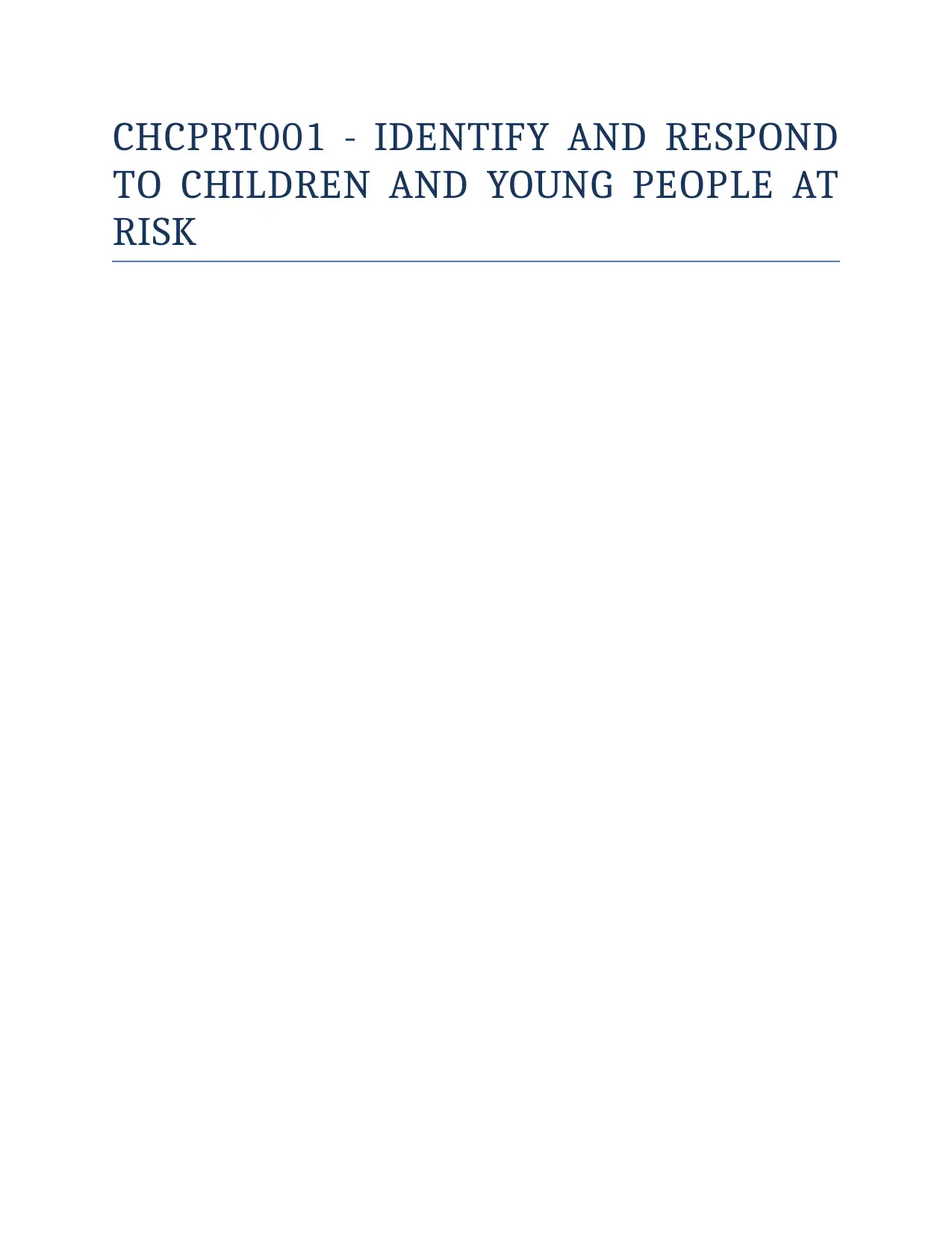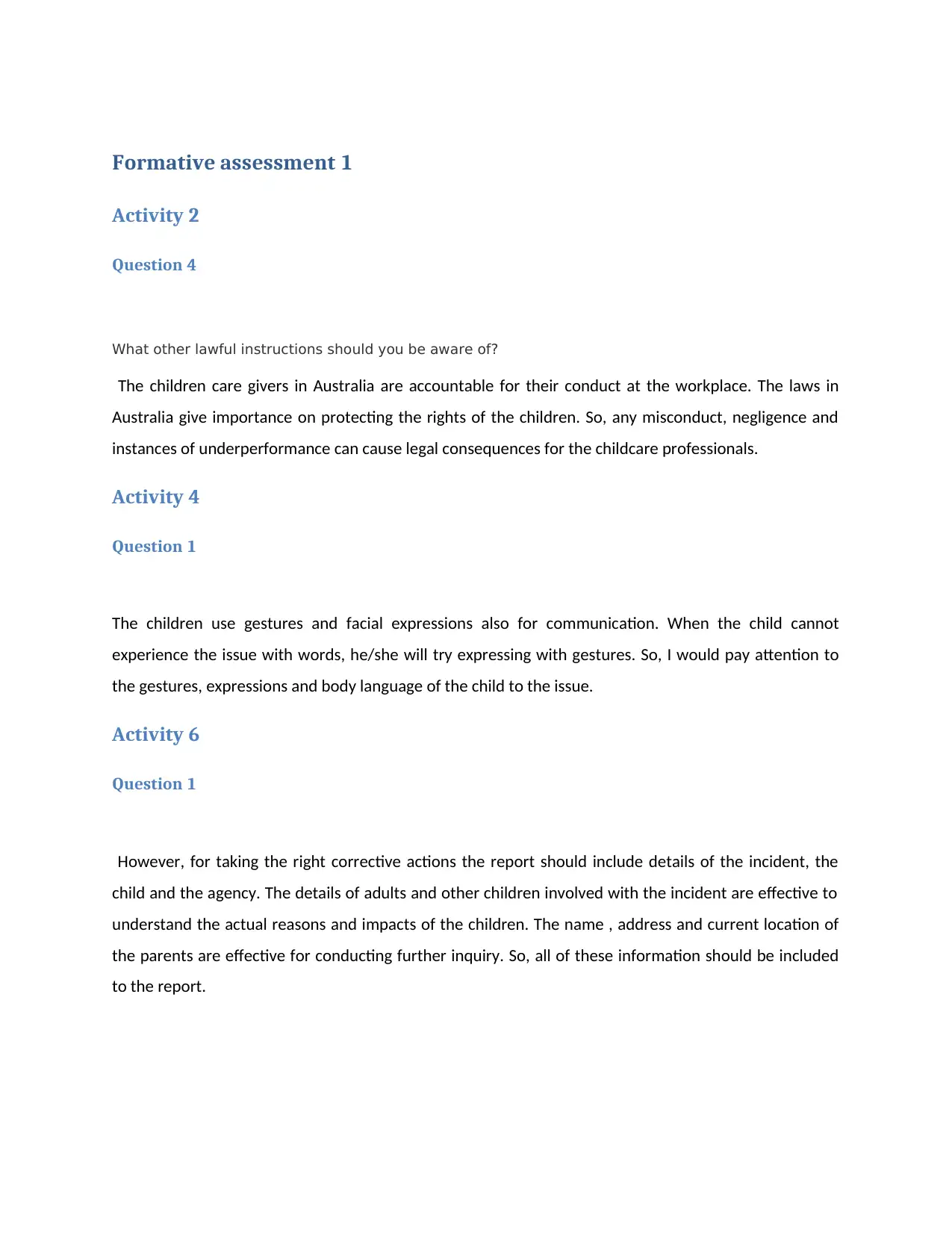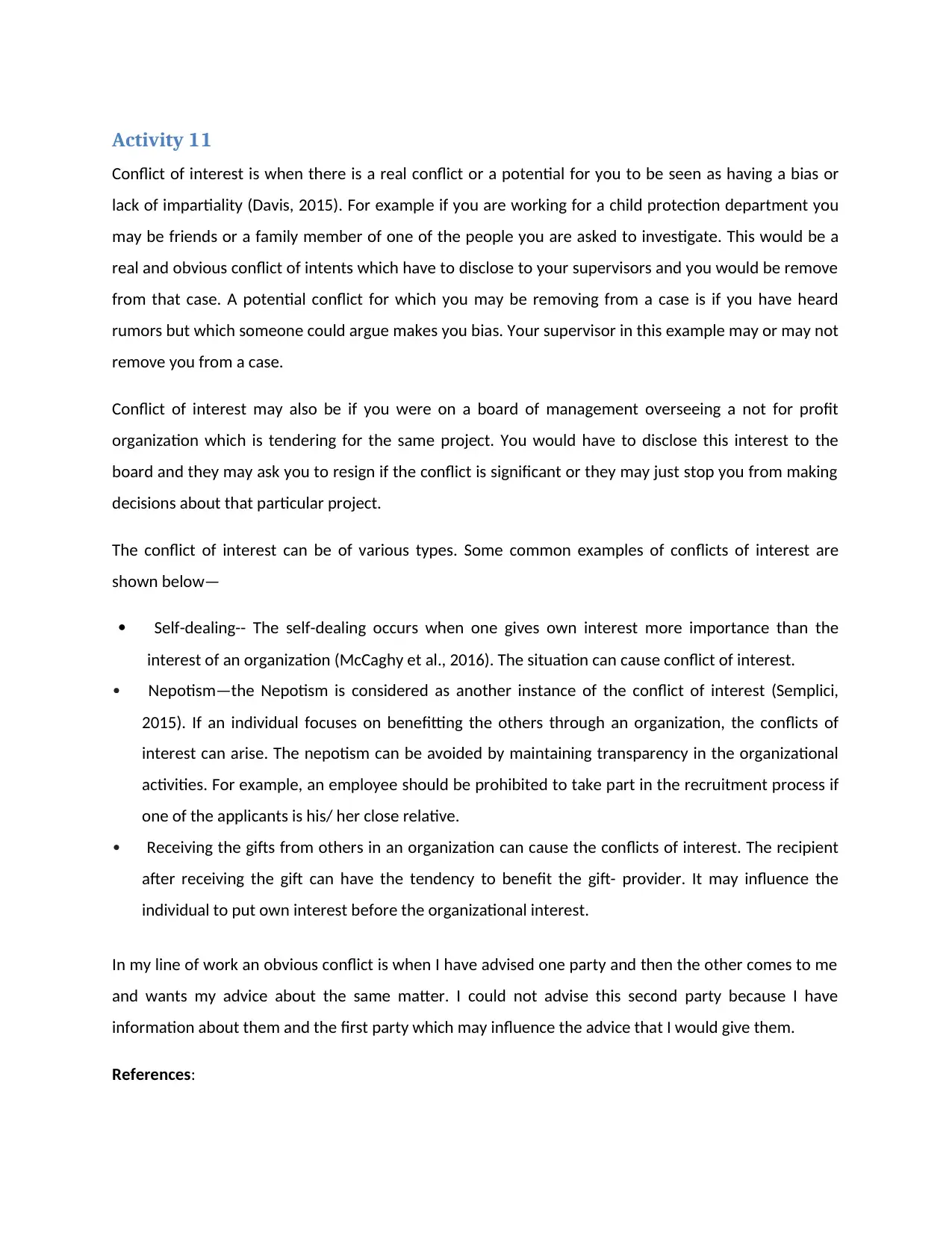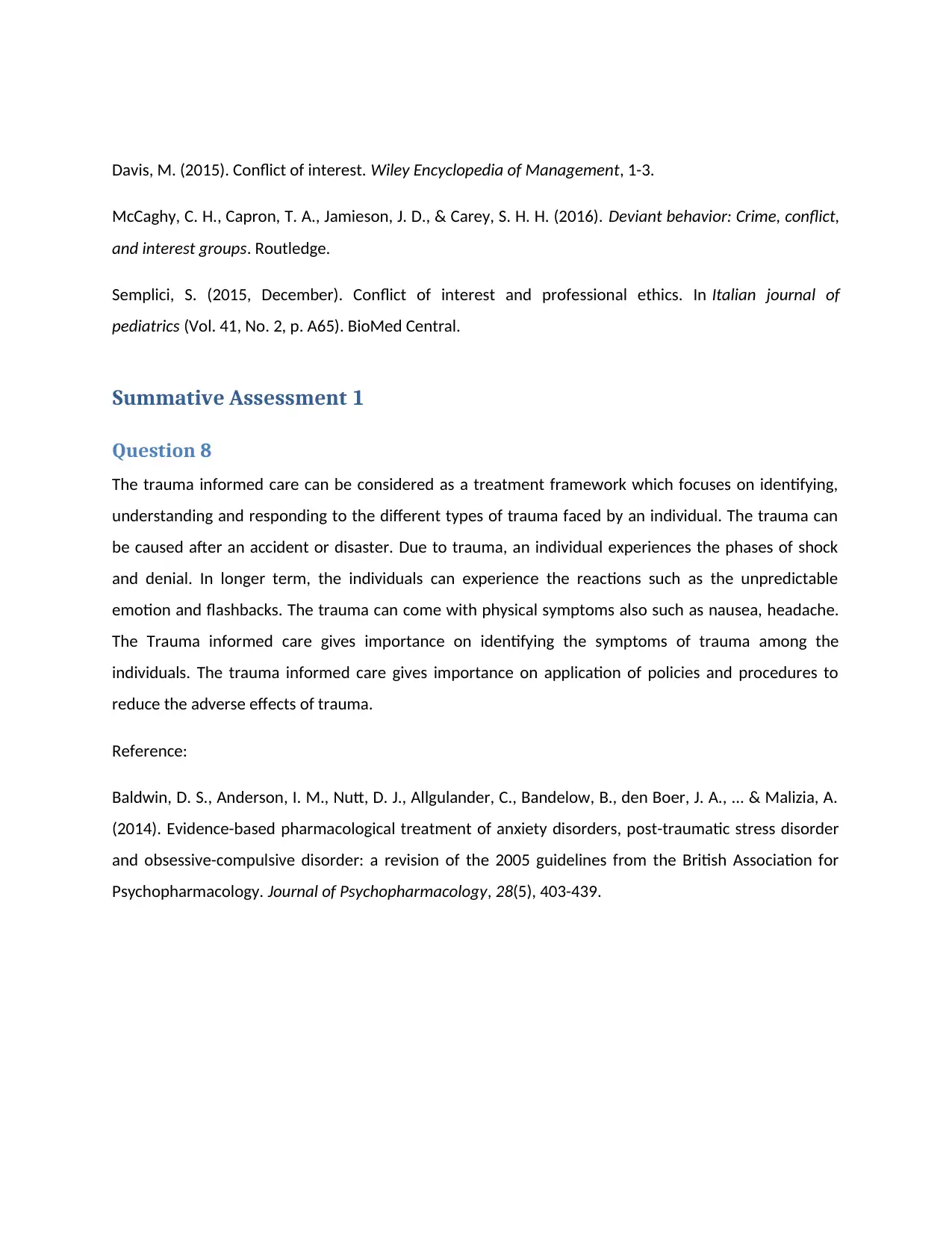CHCPRT001: Identify and Respond to Children and Young People at Risk
VerifiedAdded on 2019/09/26
|4
|945
|128
Homework Assignment
AI Summary
This document presents a comprehensive solution for the CHCPRT001 assignment, focusing on identifying and responding to children and young people at risk. It addresses key areas such as lawful instructions for childcare professionals, recognizing non-verbal communication from children, and the essential components of incident reports. The solution also delves into the concept of conflict of interest, providing examples and discussing its implications in various professional scenarios. Furthermore, the document explores trauma-informed care as a treatment framework, highlighting its importance in recognizing and responding to trauma experienced by individuals. The assignment integrates references to support the discussed concepts, providing a well-rounded understanding of the subject matter.

CHCPRT001 - IDENTIFY AND RESPOND
TO CHILDREN AND YOUNG PEOPLE AT
RISK
TO CHILDREN AND YOUNG PEOPLE AT
RISK
Paraphrase This Document
Need a fresh take? Get an instant paraphrase of this document with our AI Paraphraser

Formative assessment 1
Activity 2
Question 4
What other lawful instructions should you be aware of?
The children care givers in Australia are accountable for their conduct at the workplace. The laws in
Australia give importance on protecting the rights of the children. So, any misconduct, negligence and
instances of underperformance can cause legal consequences for the childcare professionals.
Activity 4
Question 1
The children use gestures and facial expressions also for communication. When the child cannot
experience the issue with words, he/she will try expressing with gestures. So, I would pay attention to
the gestures, expressions and body language of the child to the issue.
Activity 6
Question 1
However, for taking the right corrective actions the report should include details of the incident, the
child and the agency. The details of adults and other children involved with the incident are effective to
understand the actual reasons and impacts of the children. The name , address and current location of
the parents are effective for conducting further inquiry. So, all of these information should be included
to the report.
Activity 2
Question 4
What other lawful instructions should you be aware of?
The children care givers in Australia are accountable for their conduct at the workplace. The laws in
Australia give importance on protecting the rights of the children. So, any misconduct, negligence and
instances of underperformance can cause legal consequences for the childcare professionals.
Activity 4
Question 1
The children use gestures and facial expressions also for communication. When the child cannot
experience the issue with words, he/she will try expressing with gestures. So, I would pay attention to
the gestures, expressions and body language of the child to the issue.
Activity 6
Question 1
However, for taking the right corrective actions the report should include details of the incident, the
child and the agency. The details of adults and other children involved with the incident are effective to
understand the actual reasons and impacts of the children. The name , address and current location of
the parents are effective for conducting further inquiry. So, all of these information should be included
to the report.

Activity 11
Conflict of interest is when there is a real conflict or a potential for you to be seen as having a bias or
lack of impartiality (Davis, 2015). For example if you are working for a child protection department you
may be friends or a family member of one of the people you are asked to investigate. This would be a
real and obvious conflict of intents which have to disclose to your supervisors and you would be remove
from that case. A potential conflict for which you may be removing from a case is if you have heard
rumors but which someone could argue makes you bias. Your supervisor in this example may or may not
remove you from a case.
Conflict of interest may also be if you were on a board of management overseeing a not for profit
organization which is tendering for the same project. You would have to disclose this interest to the
board and they may ask you to resign if the conflict is significant or they may just stop you from making
decisions about that particular project.
The conflict of interest can be of various types. Some common examples of conflicts of interest are
shown below—
Self-dealing-- The self-dealing occurs when one gives own interest more importance than the
interest of an organization (McCaghy et al., 2016). The situation can cause conflict of interest.
Nepotism—the Nepotism is considered as another instance of the conflict of interest (Semplici,
2015). If an individual focuses on benefitting the others through an organization, the conflicts of
interest can arise. The nepotism can be avoided by maintaining transparency in the organizational
activities. For example, an employee should be prohibited to take part in the recruitment process if
one of the applicants is his/ her close relative.
Receiving the gifts from others in an organization can cause the conflicts of interest. The recipient
after receiving the gift can have the tendency to benefit the gift- provider. It may influence the
individual to put own interest before the organizational interest.
In my line of work an obvious conflict is when I have advised one party and then the other comes to me
and wants my advice about the same matter. I could not advise this second party because I have
information about them and the first party which may influence the advice that I would give them.
References:
Conflict of interest is when there is a real conflict or a potential for you to be seen as having a bias or
lack of impartiality (Davis, 2015). For example if you are working for a child protection department you
may be friends or a family member of one of the people you are asked to investigate. This would be a
real and obvious conflict of intents which have to disclose to your supervisors and you would be remove
from that case. A potential conflict for which you may be removing from a case is if you have heard
rumors but which someone could argue makes you bias. Your supervisor in this example may or may not
remove you from a case.
Conflict of interest may also be if you were on a board of management overseeing a not for profit
organization which is tendering for the same project. You would have to disclose this interest to the
board and they may ask you to resign if the conflict is significant or they may just stop you from making
decisions about that particular project.
The conflict of interest can be of various types. Some common examples of conflicts of interest are
shown below—
Self-dealing-- The self-dealing occurs when one gives own interest more importance than the
interest of an organization (McCaghy et al., 2016). The situation can cause conflict of interest.
Nepotism—the Nepotism is considered as another instance of the conflict of interest (Semplici,
2015). If an individual focuses on benefitting the others through an organization, the conflicts of
interest can arise. The nepotism can be avoided by maintaining transparency in the organizational
activities. For example, an employee should be prohibited to take part in the recruitment process if
one of the applicants is his/ her close relative.
Receiving the gifts from others in an organization can cause the conflicts of interest. The recipient
after receiving the gift can have the tendency to benefit the gift- provider. It may influence the
individual to put own interest before the organizational interest.
In my line of work an obvious conflict is when I have advised one party and then the other comes to me
and wants my advice about the same matter. I could not advise this second party because I have
information about them and the first party which may influence the advice that I would give them.
References:
⊘ This is a preview!⊘
Do you want full access?
Subscribe today to unlock all pages.

Trusted by 1+ million students worldwide

Davis, M. (2015). Conflict of interest. Wiley Encyclopedia of Management, 1-3.
McCaghy, C. H., Capron, T. A., Jamieson, J. D., & Carey, S. H. H. (2016). Deviant behavior: Crime, conflict,
and interest groups. Routledge.
Semplici, S. (2015, December). Conflict of interest and professional ethics. In Italian journal of
pediatrics (Vol. 41, No. 2, p. A65). BioMed Central.
Summative Assessment 1
Question 8
The trauma informed care can be considered as a treatment framework which focuses on identifying,
understanding and responding to the different types of trauma faced by an individual. The trauma can
be caused after an accident or disaster. Due to trauma, an individual experiences the phases of shock
and denial. In longer term, the individuals can experience the reactions such as the unpredictable
emotion and flashbacks. The trauma can come with physical symptoms also such as nausea, headache.
The Trauma informed care gives importance on identifying the symptoms of trauma among the
individuals. The trauma informed care gives importance on application of policies and procedures to
reduce the adverse effects of trauma.
Reference:
Baldwin, D. S., Anderson, I. M., Nutt, D. J., Allgulander, C., Bandelow, B., den Boer, J. A., ... & Malizia, A.
(2014). Evidence-based pharmacological treatment of anxiety disorders, post-traumatic stress disorder
and obsessive-compulsive disorder: a revision of the 2005 guidelines from the British Association for
Psychopharmacology. Journal of Psychopharmacology, 28(5), 403-439.
McCaghy, C. H., Capron, T. A., Jamieson, J. D., & Carey, S. H. H. (2016). Deviant behavior: Crime, conflict,
and interest groups. Routledge.
Semplici, S. (2015, December). Conflict of interest and professional ethics. In Italian journal of
pediatrics (Vol. 41, No. 2, p. A65). BioMed Central.
Summative Assessment 1
Question 8
The trauma informed care can be considered as a treatment framework which focuses on identifying,
understanding and responding to the different types of trauma faced by an individual. The trauma can
be caused after an accident or disaster. Due to trauma, an individual experiences the phases of shock
and denial. In longer term, the individuals can experience the reactions such as the unpredictable
emotion and flashbacks. The trauma can come with physical symptoms also such as nausea, headache.
The Trauma informed care gives importance on identifying the symptoms of trauma among the
individuals. The trauma informed care gives importance on application of policies and procedures to
reduce the adverse effects of trauma.
Reference:
Baldwin, D. S., Anderson, I. M., Nutt, D. J., Allgulander, C., Bandelow, B., den Boer, J. A., ... & Malizia, A.
(2014). Evidence-based pharmacological treatment of anxiety disorders, post-traumatic stress disorder
and obsessive-compulsive disorder: a revision of the 2005 guidelines from the British Association for
Psychopharmacology. Journal of Psychopharmacology, 28(5), 403-439.
1 out of 4
Related Documents
Your All-in-One AI-Powered Toolkit for Academic Success.
+13062052269
info@desklib.com
Available 24*7 on WhatsApp / Email
![[object Object]](/_next/static/media/star-bottom.7253800d.svg)
Unlock your academic potential
Copyright © 2020–2025 A2Z Services. All Rights Reserved. Developed and managed by ZUCOL.





